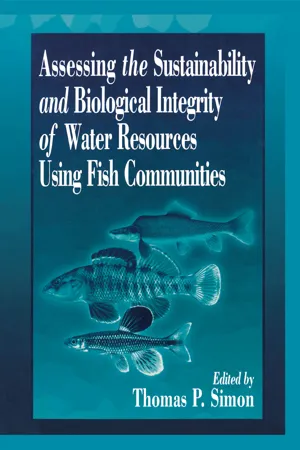
eBook - ePub
Assessing the Sustainability and Biological Integrity of Water Resources Using Fish Communities
- 610 pages
- English
- ePUB (mobile friendly)
- Available on iOS & Android
eBook - ePub
Assessing the Sustainability and Biological Integrity of Water Resources Using Fish Communities
About this book
This book examines the application of fish community characteristics to evaluate the sustainability and biological integrity of freshwaters. Topics include perspectives on use of fish communities as environmental indicators in program development, collaboration, and partnership forming; influence of specific taxa on assessment of the IBI; regional applications for areas where the IBI had not previously been developed; and specific applications of the IBI developed for coldwater streams, inland lakes, Great Lakes, reservoirs, and tailwaters.
Frequently asked questions
Yes, you can cancel anytime from the Subscription tab in your account settings on the Perlego website. Your subscription will stay active until the end of your current billing period. Learn how to cancel your subscription.
At the moment all of our mobile-responsive ePub books are available to download via the app. Most of our PDFs are also available to download and we're working on making the final remaining ones downloadable now. Learn more here.
Perlego offers two plans: Essential and Complete
- Essential is ideal for learners and professionals who enjoy exploring a wide range of subjects. Access the Essential Library with 800,000+ trusted titles and best-sellers across business, personal growth, and the humanities. Includes unlimited reading time and Standard Read Aloud voice.
- Complete: Perfect for advanced learners and researchers needing full, unrestricted access. Unlock 1.4M+ books across hundreds of subjects, including academic and specialized titles. The Complete Plan also includes advanced features like Premium Read Aloud and Research Assistant.
We are an online textbook subscription service, where you can get access to an entire online library for less than the price of a single book per month. With over 1 million books across 1000+ topics, we’ve got you covered! Learn more here.
Look out for the read-aloud symbol on your next book to see if you can listen to it. The read-aloud tool reads text aloud for you, highlighting the text as it is being read. You can pause it, speed it up and slow it down. Learn more here.
Yes! You can use the Perlego app on both iOS or Android devices to read anytime, anywhere — even offline. Perfect for commutes or when you’re on the go.
Please note we cannot support devices running on iOS 13 and Android 7 or earlier. Learn more about using the app.
Please note we cannot support devices running on iOS 13 and Android 7 or earlier. Learn more about using the app.
Yes, you can access Assessing the Sustainability and Biological Integrity of Water Resources Using Fish Communities by Thomas P. Simon in PDF and/or ePUB format, as well as other popular books in Biological Sciences & Biology. We have over one million books available in our catalogue for you to explore.
Information
Section II
Guild and Metrics Determination
6 Assessment of Balon’s Reproductive Guilds with Application to Midwestern North American Freshwater Fishes
Thomas P. Simon
CONTENTS
6.1 Introduction
6.2 Background
6.3 Reproductive Guild Placement of Midwestern North American Fishes
6.3.1 A. Nonguarders
6.3.1.1 Open Substratum Spawners (A.1)
6.3.1.2 Brood Hiders (A.2)
6.3.2 B. Guarders
6.3.2.1 Substratum Choosers (B.1)
6.3.2.2 Nest Spawners (B.2)
6.3.3 C. Bearers
6.3.3.1 External Bearers (C.1)
6.3.3.2 Internal Bearers (C.2)
6.4 Discussion
6.5 Conclusion
Acknowledgments
References
6.1 INTRODUCTION
Similarity in evolutionary peaks and patterns in fishes enabled Balon (1975; 1981; 1985) to develop a framework for classifying reproductive styles. Balon’s concept built on Kryzhanovsky’s (1949) reasoning that “adaptations of fishes for spawning and development reflect not only the essential ecological factors of the embryonic period, but also the essential factors of all the other intervals of life.” This reproductive guild classification was based mainly on form and function in early developmental intervals, on preferred spawning grounds, and on features of reproductive behavior. The difficulty with such a system is that reproductive behavior was well known for less than 2% of the 20,000 known species of fish (Breder and Rosen, 1966), early life history of fishes were imprecisely known representing less than 1% of the known species of fish (Simon, 1986), and, by Balon’s own admission, the guild concept was a preliminary proposal reviewing the current knowledge at that time (Balon, 1975).
The present study examines the proper placement of midwestern North American species. The reproductive guild classification is becoming increasingly important as researchers develop alternative characteristics or “metrics” for evaluating North American stream fishes. The Index of Biotic Integrity (Karr et al., 1986) is an important tool that has been developed for determining biological resource quality using multiple aspects of stream fish communities. Alternative metrics include reproductive attributes such as proportion of simple lithophils (Simon, 1991; 1992) or ratio of nest spawning minnows to broadcast spawning minnows (Goldstein et al., 1994). To develop these metrics, species are categorized into appropriate guilds. Inaccurate assessment of biological integrity of a stream reach would r...
Table of contents
- Cover
- Title Page
- Copyright Page
- Foreword
- Preface
- Acknowledgments
- Contributors
- Reviewers
- Table of Contents
- Section I: Perspectives
- Section II: Guild and Metrics Determination
- Section III: Regional Applications of the IBI
- Section IV: Application to Freshwater Resource Types Other than Wadeable Warmwater Streams
- Section V: Data Validation
- Index